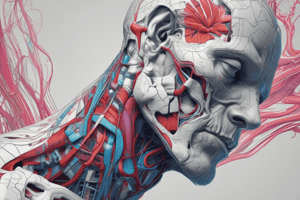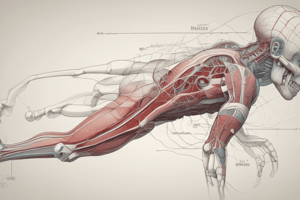Podcast
Questions and Answers
Which part of the small intestine receives bile and pancreatic juice from the pancreas?
Which part of the small intestine receives bile and pancreatic juice from the pancreas?
- Jejunum
- Duodenum (correct)
- Renal cortex
- Ileum
What is the main function of the exocrine part of the pancreas?
What is the main function of the exocrine part of the pancreas?
- Storing red blood cells and platelets
- Regulating blood sugar levels
- Filtering waste and excess fluids from the blood
- Producing digestive enzymes (correct)
Which structure collects urine in the kidney?
Which structure collects urine in the kidney?
- Renal medulla
- Renal cortex
- Renal pelvis (correct)
- Collecting ducts
What is the function of the white pulp in the spleen?
What is the function of the white pulp in the spleen?
Which liver function involves removing toxins from the blood?
Which liver function involves removing toxins from the blood?
What is the main site of nutrient absorption in the small intestine?
What is the main site of nutrient absorption in the small intestine?
Which pancreatic duct carries digestive enzymes to the duodenum?
Which pancreatic duct carries digestive enzymes to the duodenum?
What is the function of the nephrons in the kidney?
What is the function of the nephrons in the kidney?
Which layer of the small intestine is responsible for absorption?
Which layer of the small intestine is responsible for absorption?
What is the function of the hepatocytes in the liver?
What is the function of the hepatocytes in the liver?
Flashcards are hidden until you start studying
Study Notes
Intestines
- Also known as the small intestine or small bowel
- Function: absorbs nutrients from food into the bloodstream
- Located in the abdominal cavity, between the stomach and large intestine
- Divided into three parts:
- Duodenum: receives bile and pancreatic juice from the pancreas
- Jejunum: main site of nutrient absorption
- Ileum: final section before entering the large intestine
- Wall layers:
- Mucosa: innermost layer, absorptive surface
- Submucosa: connective tissue layer
- Muscularis: muscular layer
- Serosa: outermost layer, connects to peritoneum
Pancreas
- Located in the upper left abdomen, behind the stomach
- Functions:
- Exocrine: produces digestive enzymes for protein, carbohydrate, and fat digestion
- Endocrine: produces hormones insulin and glucagon to regulate blood sugar levels
- Components:
- Head: connected to the duodenum
- Body: middle section
- Tail: thin, tapering end
- Ducts:
- Pancreatic duct: carries digestive enzymes to the duodenum
- Accessory pancreatic duct: smaller duct that also drains into the duodenum
Kidneys
- Located in the upper back of the abdominal cavity, one on each side of the spine
- Functions:
- Filter waste and excess fluids from the blood
- Regulate electrolyte levels
- Produce hormones that help regulate blood pressure and produce red blood cells
- Structures:
- Renal cortex: outer layer, contains nephrons (functional units)
- Renal medulla: inner layer, contains collecting ducts and blood vessels
- Renal pelvis: funnel-shaped structure that collects urine
Spleen
- Located in the upper left abdomen, just below the diaphragm
- Functions:
- Filters the blood, removing old or damaged red blood cells
- Stores red blood cells, platelets, and white blood cells
- Acts as a reservoir for blood
- Structures:
- White pulp: lymphoid tissue, containing immune cells
- Red pulp: filters the blood, removing old or damaged cells
Liver
- Located in the upper right abdomen, beneath the diaphragm
- Functions:
- Detoxification: removes toxins from the blood
- Metabolism: regulates carbohydrate, protein, and fat metabolism
- Storage: stores glycogen, vitamins, and minerals
- Structures:
- Lobes: four lobes, each with its own blood supply
- Hepatic ducts: collect bile from the liver and drain into the gallbladder
- Hepatocytes: functional units, responsible for metabolic functions
Studying That Suits You
Use AI to generate personalized quizzes and flashcards to suit your learning preferences.




